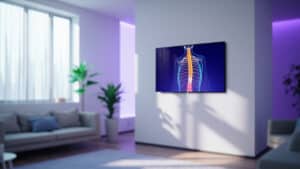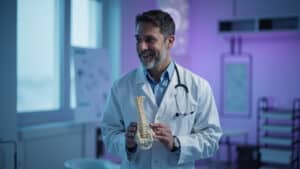Can A Herniated Disc Cause Muscle Spasms In The Leg? A Medical Expert Explains
Written by Dr. Matthias Wiederholz, MD, Board Certified in Physical Medicine & Rehabilitation, Pain Medicine, Sports Medicine, and Regenerative Medicine
Quick Insights
A herniated disc occurs when spinal disc material presses on nearby nerves. Can a herniated disc cause muscle spasms in the leg? Yes—disc compression can disrupt nerve signals, often triggering painful, involuntary muscle contractions. Prompt specialist evaluation is crucial for lasting relief and function restoration.Medical studies confirm this connection.
Key Takeaways
- Muscle spasms from a herniated disc often result from nerve compression disrupting normal muscle signals.
- Symptoms can include sharp leg pain, leg weakness, tingling, or sudden cramping beyond simple aches.
- Most patients with disc-related muscle spasms respond well to non-surgical treatments, avoiding surgery.
- Persistent leg spasms may indicate underlying nerve issues that, if left unaddressed, can potentially lead to loss of mobility or function.
Why It Matters
Struggling with unexplained leg cramps or spasms can sideline you from the activities you love. Understanding that a herniated disc may be the root cause allows you to seek the right diagnosis and reclaim your mobility—without unnecessary surgery or long-term disability.
As a quadruple board-certified physician specializing in interventional pain and regenerative medicine, I have witnessed firsthand how often patients ask: Can a herniated disc cause muscle spasms in the leg?
A herniated disc is when disc material bulges or leaks out of its normal place, pressing on nearby nerves. This not only disrupts nerve signals—often triggering painful, involuntary muscle contractions—but can leave you sidelined from your favorite activities and unable to move comfortably around Houston.
Every week, I see individuals whose unexplained leg cramps, twitching, or weakness stem from disc problems, not just overuse or aging. Clinical research demonstrates that leg muscle spasms frequently accompany herniated discs when nerve irritation is present, validating what many patients already feel in their daily lives with direct evidence from guideline-based studies.
If nagging spasms have disrupted your active lifestyle or left you feeling overlooked by traditional care, you’re in the right place to find clarity and options. Learn more about my background as a regenerative medicine specialist.
Learn about advanced back pain treatment options here.
For those interested in related spinal conditions, explore our comprehensive guide to L5-S1 bulging disc.
What Is a Herniated Disc?
A herniated disc occurs when the soft inner core of a spinal disc—the nucleus pulposus—pushes through a crack in its tough exterior (the annulus fibrosus). This displacement can put pressure on nearby spinal nerves, causing a range of symptoms that often catch patients by surprise.
Most herniated discs are found in the lower back, particularly in people aged 30 to 50—the period when spinal discs are most vulnerable to wear, injury, and degeneration. In my practice, many active adults are shocked to discover that their disc herniation wasn’t caused by a high-impact injury, but by something as simple as improper lifting, twisting, or even years of poor posture. Other risk factors include genetics, aging, and long stretches of inactivity.
Not everyone with a herniated disc feels pain, but when bulging disc material compresses or irritates a nerve, you may experience pain, numbness, or muscle dysfunction in the affected limb. According to clinical research, almost 5% of adults can expect to develop a herniated disc at some point in their life, with disc bulging a common cause of persistent back and leg issues for many individuals. See findings on age and risk.
Understanding how disc anatomy impacts your symptoms is often the first—and most important—step toward finding real relief.
Read about degenerative disc disease treatment options.
Can a Herniated Disc Cause Muscle Spasms in the Leg?
Absolutely—a herniated disc can directly cause muscle spasms in your leg. When the displaced disc material presses on or irritates a spinal nerve root, it disrupts the nerve’s normal communication with your muscles. The result? Suddenly, often severe cramping or tightening known as muscle spasms.
Why does this occur? The nerve roots that branch from your lower spine (“lumbar” region) are responsible for sending signals to your leg muscles. Compression or inflammation of these nerves upsets that delicate balance, leading to:
- Involuntary muscle contractions (spasms)
- Persistent muscle tightness not relieved by stretching
- Sudden cramps, especially with certain movements
- Episodes of twitching or jerking in the leg
In my experience as a quadruple board-certified regenerative specialist, I frequently see patients who describe their spasms as intense cramps that strike without warning—or as a deep aching tightness that disrupts daily life and sleep. Many have tried countless remedies for “sore muscles,” not realizing the true source is nerve irritation from a disc.
This clinical connection is well established: lumbar disc herniation can lead to radiculopathy (nerve pain), presenting with pain, numbness, muscle weakness, and yes, muscle spasms in the affected leg, according to leading clinical guidelines.
Recognizing this link is critical. Instead of chasing muscle-only treatments, you need targeted care that addresses the disc and nerve root itself. Every week, I help patients move from frustration to real understanding when we identify this root cause.
Learn more about understanding S1 nerve distribution and what symptoms may mean for you.
Why Do Muscle Spasms Happen with Disc Problems?
Muscle spasms linked to herniated discs arise primarily due to nerve compression and the body’s inflammatory response. Let’s break this down clinically:
Nerve Compression and Muscle Response
When a herniated disc presses against a spinal nerve, it alters how the nerve transmits signals. Disrupted nerve communication can cause the connected muscles to contract involuntarily, resulting in spasms, cramps, or “tightness.”
I see this in patients who find that certain positions—like bending, twisting, or even sitting—can instantly trigger a painful muscle clampdown in the leg or back. These spasms can stop you in your tracks, making simple movements feel impossible.
Chemical and Inflammatory Causes
Disc injury isn’t just a mechanical issue. Chemical irritants released from the damaged disc—known as inflammatory mediators—can irritate nearby nerves, amplifying pain and muscle spasm. It’s possible for patients to experience severe spasms even if their MRI shows only mild disc bulging.
As highlighted by expert recommendations, Chemical mediators released during disc herniation can significantly contribute to pain, sometimes comparable to the effects of physical compression. learn more about chemical irritation and muscle spasm.
As a regenerative medicine specialist, my focus is not just to decompress nerves, but also to calm inflammation and foster a healing environment—yielding lasting relief for patients with disc-driven muscle symptoms.
Read about effective treatment options for L5-S1 disc herniation pain.
Other Symptoms of Disc Herniation in the Leg
A herniated disc can produce a broader array of symptoms beyond muscle spasms. Understanding the full symptom picture is key to early diagnosis and personalized treatment.
Pain Patterns
Herniated discs often cause “radicular pain”—a shooting or burning discomfort that radiates from your lower back or buttocks down the hip, thigh, calf, and even into the foot. This pain may be sharp, electric, or deep and throbbing, and is often worsened by movement or prolonged sitting.
Weakness and Sensory Changes
Nerve compression can also manifest as:
- Muscular weakness (“heavy” or “jelly-like” leg feeling)
- Numbness or tingling (pins and needles)
- Loss of coordination or frequent stumbling
In my Houston clinic, it’s common to see patients who suddenly notice difficulty lifting their foot, trouble climbing stairs, or altered sensation in a well-defined part of the lower leg.
Important research confirms: disc herniation symptoms may range from no symptoms at all to profound pain, muscle dysfunction, and neurological changes—underscoring the need for precise evaluation. See the latest systematic review on symptom range.
When leg symptoms escalate or appear suddenly, don’t wait:
Seek urgent medical care if you develop:
- New or total loss of leg strength
- Loss of bladder or bowel control
- Numbness in your groin or inner thighs
These may indicate a rare but serious condition requiring immediate attention.
Explore emergency symptoms of a herniated disc.
How Are Herniated Discs Diagnosed?
Diagnosis begins with a detailed history and hands-on exam. I focus on understanding your symptoms—where the pain or spasms are, what worsens or relieves them, and any recent injuries or activities that may have triggered your episode.
Physical and Neurological Exams
A thorough assessment involves checking muscle strength, reflexes, and skin sensation in both legs. Specific maneuvers, like the straight-leg raise test, help pinpoint nerve involvement: if lifting your straightened leg reproduces pain or tingling, it strongly suggests a herniated disc pressing on a nerve.
This simple test is one of the most sensitive ways to detect nerve compression from a disc and is a staple in my evaluation protocol. Explore details on the straight-leg raise test.
Imaging Tests
If your symptoms are severe, persistent, or not clearly linked to an identifiable pattern, advanced imaging may be recommended:
- MRI: Provides a detailed look at discs and nerves; most helpful for treatment planning.
- CT scan: Sometimes used to visualize problematic discs or bone spurs.
I always combine physical exam findings with imaging to ensure the most accurate diagnosis and tailored treatment plan.
Read about symptoms of a bulging disc in the neck, C5-C6.
Non-Surgical and Minimally Invasive Treatment Options
Most patients with muscle spasms from a herniated disc do NOT require surgery. My regenerative approach in Houston prioritizes non-invasive and minimally invasive options that truly address the origin of your pain.
Physical Therapy and Conservative Care
Physical therapy forms the foundation of most successful treatment plans. Research shows that targeted exercise—particularly focused on core strength and flexibility—can rapidly decrease muscle spasms, improve movement, and reduce recurrence of symptoms. See research on exercise-based rehab.
Additional conservative options include:
- Nonsteroidal anti-inflammatory drugs (NSAIDs)
- Muscle relaxants, especially for severe spasms interfering with sleep
- Ergonomic adjustments to reduce strain
- Temporary activity modification
Clinical guidelines affirm that most people experience significant improvement within weeks to months using these strategies, and the vast majority can avoid surgery when following a structured program reviewing the latest conservative care outcomes.
In my practice, I emphasize not just quick pain relief, but strategies for long-term resilience and prevention. Restoring your body’s innate function is at the heart of my approach.
Find herniated disc exercises that can help reduce the risk of recurrence.
The Discseel® Procedure
When leg spasms and symptoms don’t resolve with conservative care, I’m proud to offer Houston’s most advanced minimally invasive solution: the Discseel® Procedure. This outpatient technique uses a biologic fibrin sealant to “patch and repair” damaged discs, stimulating natural healing and collagen regeneration, all without cutting, fusing, or installing hardware.
Visit the official Discseel® website for procedure details.
As one of only three certified Discseel® master instructors worldwide—and the first in Houston—I’ve seen patients regain mobility and return to their active lives, often within days. Discseel® is uniquely effective for those with discogenic pain, failed back surgery, or recurrent disc herniations.
Read Discseel® reviews and experiences from real patients.
Comparing Outcomes: Surgery vs. Regenerative Treatments
Surgical intervention is generally reserved for the most severe or stubborn cases—such as when disabling weakness or loss of bladder/bowel control is present. While surgery can help some, it carries inherent risks, extended recovery, and long-term limitations.
Recent systematic reviews show that both surgical and non-surgical treatments can improve function, but surgery should usually be a last resort after other avenues have failed. Full systematic review on surgical vs. conservative outcomes; see comparative outcomes data.
Having personally performed over 10,000 minimally invasive spine procedures, I believe that regeneration—rather than removal or fusion—empowers you to preserve your mobility and lifestyle. My commitment as a master instructor is to bring world-class, evidence-driven solutions directly to my Houston patients.
Explore the Disc Tear Treatment blog to understand the importance of restoring spinal integrity.
Why Choose Performance Pain & Sports Medicine in Houston?
Unlike larger clinics, my practice offers a highly personalized, boutique experience focused on restoring your function and quality of life. Here’s what sets us apart:
- Every patient receives direct, expert care—no hand-offs, no generic protocols.
- You benefit from my dual locations in Houston and Lawrenceville, as well as my national leadership in regenerative spine techniques—including Discseel®, Superion® Interspinous Spacer, and advanced spinal cord stimulation.
- Comprehensive support includes exercise, ergonomic coaching, and lifestyle adjustments—because true healing extends beyond procedures.
As a quadruple board-certified physician trained directly by Dr. Kevin Pauza, I provide both cutting-edge knowledge and real-world compassion. My goal is always to empower you to reclaim your active life, with the least disruption possible.
For more on local treatment options in Houston, visit our Houston location page.
“After struggling for years with leg cramps and numbness from a herniated disc, I finally found Dr. Wiederholz and his team. The Discseel® Procedure gave me my life back—pain free and moving again. I wish I had found this place sooner!”
— See Linda’s story on Google
What Our Patients Say on Google
Patient experiences are at the heart of my practice, and nothing speaks louder than the real journeys of those who have faced years of pain and uncertainty. I recently received feedback that truly captures the transformation we strive for with advanced, non-surgical spine care.
One reviewer shared her story of living with multiple lumbar disc herniations and constant pain, even being told by a surgeon that spinal fusion was her only option. She decided to seek out the Discseel® Procedure after thorough research and a detailed consultation.
“Thus is going to be long because i want everyone to understand what i have been going through. I had herniations on all my lumbar discs on both sides of my spine and also on the first sacral disc. I couldn’t walk without leaning on something and was in constant pain. Went to a spine surgeon who wanted to fuse my bottom lumbar disc to my sacral disc. When I asked him about the pain farther up the lumbar spine, he just said that was referred pain. Deciding against surgery I began researching treatment options. That’s when I discovered Dr. Wiederholz and his Discseel procedure. I did my homework and read everything I could find on it.
After my appointment with Dr. Wiederholz, I decided to have the Discseel procedure. I was desperate and felt i had nothing to lose and everything to gain if it worked. I can’t begin to explain how thrilled I am with the results. The doctor injected the fibrin into all my lumbar disc’s and one sacral disc. I had about four days of mild procedural pain and the pain meds he gave me took care of that. The doctor said it would take three to six months to get the full effects as the fibrin would attach to the disc and seal it up as it heals. He also said some people had results much quicker. I am so pleased to tell you that within two weeks my back felt so much better. By the time I went for my six week follow-up, I had no more pain and could walk normal.
After years of pain and lots of pain meds, I feel like Dr. Wiederholz gave me a new lease on life. I’m retired and wasn’t able to travel with my husband because of my back. We now have a trip planned to the Virgin Islands! I’m not exaggerating when I tell you that my back is completely healed. I know it’s a little pricey but it’s worth every dime. I haven’t felt this good in twenty years. Dr. Wiederholz was extremely patient and explained numerous options available to help manage my pain but I knew I wanted the Discseel procedure and I can’t begin to say how blessed I am to have found Dr. Wierderholz. He is the greatest and literally gave me my life back! I highly recommend him to anyone dealing with pain.”
— Linda
Stories like Linda’s remind me why it’s so important to look beyond surgery and offer hope through innovative, evidence-based solutions for disc-related muscle spasms and pain.
Herniated Disc and Muscle Spasms: Expert Care in Houston, TX
Living in Houston means enjoying an active lifestyle, but it also means that back and leg pain can quickly disrupt your daily routine. As a Houston-based physician, I see firsthand how our city’s fast pace and diverse population bring unique challenges—and opportunities—for treating herniated discs and muscle spasms.
Houston’s climate and culture encourage year-round movement, from walking trails to sports leagues. This makes timely, effective care for disc-related leg symptoms even more critical. At Performance Pain & Sports Medicine, we offer advanced diagnostics and the Discseel® Procedure right here in Houston, so you don’t have to travel far for world-class spine care.
Our commitment to the Houston community goes beyond procedures. We provide personalized, minimally invasive solutions that help you return to your favorite activities—whether that’s a jog at Memorial Park or simply keeping up with your family.
If you’re in Houston and struggling with muscle spasms from a herniated disc, don’t wait for symptoms to worsen. Schedule a consultation today to see if you’re a candidate for the Discseel® Procedure and take the first step toward lasting relief and restored mobility.
Learn about L5-S1 pain and its causes, symptoms, and treatment.
Conclusion
Can a herniated disc cause muscle spasms in the leg? Absolutely—and recognizing this connection is the first step toward real relief. I see every day how nerve compression from a herniated disc can trigger painful spasms, cramping, and weakness that disrupt your life in Houston. The good news is that most patients regain mobility and comfort with non-surgical, regenerative treatments that address both the disc and nerve root.
My approach combines advanced options like the Discseel® Procedure, Superion® Interspinous Spacer, and spinal cord stimulation to help you reclaim activities you love—without invasive surgery. As a quadruple board-certified regenerative specialist, I am committed to delivering personalized, compassionate care that restores your function and quality of life. Advanced regenerative care, without invasive surgery.
If you’re ready to stop missing out on family events or daily activities due to chronic back pain, I invite you to schedule a prompt appointment—often available within 1–2 weeks. Early intervention leads to better outcomes and helps you avoid unnecessary surgery. Let’s help you reclaim your life.
This article is for educational purposes only and should not be used as a substitute for professional medical advice, diagnosis, or treatment. Always seek the advice of your physician or other qualified healthcare provider with any questions you may have regarding a medical condition or treatment options. Never disregard professional medical advice or delay in seeking it because of something you have read in this article.
Frequently Asked Questions
Can a herniated disc cause muscle spasms in the leg?
Yes, a herniated disc can directly cause muscle spasms in the leg. When disc material presses on spinal nerves, it disrupts normal muscle signals, leading to cramping, tightness, or sudden spasms. This is a common reason patients experience unexplained leg discomfort or twitching, especially after back injuries or with certain movements.
Explore more about what herniated disc symptoms, causes, and treatment options look like.
Where can I find advanced, non-surgical treatment for herniated disc muscle spasms in Houston?
You can find advanced, non-surgical care for muscle spasms from herniated discs at my Houston practice. I offer personalized evaluations and minimally invasive options—including the Discseel® Procedure—so you can return to your active lifestyle quickly and safely, right here in Houston.
As an active individual, how do I know if I need regenerative treatment instead of surgery?
If you’re struggling with persistent leg spasms, pain, or weakness that hasn’t improved with rest or physical therapy, regenerative treatments may be right for you. Most patients benefit from non-surgical options and avoid surgery altogether. I help you determine the best path forward based on your unique symptoms and goals.
Looking for more resources? Browse our blog on everything you need to know about new treatments for ruptured discs.

















